Pope Alexander II, born Anselm of Baggio, was the head of the Roman Catholic Church and ruler of the Papal States from 1061 to his death in 1073. Born in Milan, Anselm was deeply involved in the Pataria reform movement. Elected according to the terms of his predecessor's bull, In nomine Domini, Anselm's was the first election by the cardinals without the participation of the people and minor clergy of Rome.

Pope Gregory X, born Teobaldo Visconti, was head of the Catholic Church and ruler of the Papal States from 1 September 1271 to his death and was a member of the Secular Franciscan Order. He was elected at the conclusion of a papal election that ran from 1268 to 1271, the longest papal election in the history of the Catholic Church.

Pope Gregory VII, born Hildebrand of Sovana, was head of the Catholic Church and ruler of the Papal States from 22 April 1073 to his death in 1085. He is venerated as a saint in the Catholic Church.

The 1846 papal conclave was triggered after death of Pope Gregory XVI on 1 June 1846. Fifty of the 62 members of the College of Cardinals assembled in the Quirinal Palace, one of the papal palaces in Rome and the seat of two earlier 19th century conclaves. The conclave began on 14 June and had to elect a pope who would not only be head of the Catholic Church but also the head of state and government of the Papal States, the extensive lands around Rome and Northern Italy which the Catholic Church governed.

The Archdiocese of Genoa is a Latin Church ecclesiastical territory or diocese of the Catholic Church in Italy. Erected in the 3rd century, it was elevated to an archdiocese on 20 March 1133. The archdiocese of Genoa was, in 1986, united with the Diocese of Bobbio-San Colombano, forming the Archdiocese of Genoa-Bobbio; however a split in 1989 renamed it the "Archdiocese of Genoa."

The Archdiocese of Ancona–Osimo is a joint ecclesiastical territory and metropolitan see of the Catholic Church in the Marche region of Italy.

The Archdiocese of Aix-en-Provence and Arles is a Latin Church ecclesiastical territory or archdiocese of the Catholic Church in France. The archepiscopal see is located in the city of Aix-en-Provence. The diocese comprises the department of Bouches-du-Rhône, in the Region of Provence-Alpes-Côte d'Azur. It is currently a suffragan of the Archdiocese of Marseilles and consequently the archbishop no longer wears the pallium.

The Roman Catholic Diocese of Imola is a territory in Romagna, northern Italy. It is a suffragan of the Archdiocese of Bologna. The diocese had originally been a suffragan of the metropolitan of Milan, and was then subject to the Archbishop of Ravenna until 1582, when Pope Gregory XIII made Bologna an archbishopric and assigned it two suffragans, Imola and Cervia. In 1604, however, Pope Clement VIII returned them to the metropolitanate of Ravenna. Pope Pius VII transferred Imola back to the metropolitanate of Bologna.

The Archdiocese of Turin is a Latin Church ecclesiastical territory of the Catholic Church in Italy.

The Diocese of Bergamo is a see of the Catholic Church in Italy, and is a suffragan of the Archdiocese of Milan. Geographically, Bergamo stood between the mainland interests of the Republic of Venice, and the territory of the Duchy of Milan. The duchy was regularly contested by the French and the Holy Roman Empire, which brought about repeated military operations. Internally, from the 12th to the 15th century, there was the usual party strife between the Guelphs, who generally supported the political and religious policies of the Papacy; and the Ghibellines, who generally supported the Emperors. As Kings of Italy, the emperors were feudal overlords of Lombardy.

The Diocese of Rieti is a Latin Church ecclesiastical territory or diocese of the Catholic Church in Italy. It is immediately exempt to the Holy See. Its cathedra is in St. Mary Cathedral in the episcopal see of Rieti.

The Archdiocese of Pisa is a metropolitan see of the Catholic Church in Pisa, Italy. It was founded in the 4th century and elevated to the dignity of an archdiocese on 21 April 1092 by Pope Urban II. The seat of the bishop is the cathedral of the Assumption in the Piazza del Duomo.

The Diocese of Pavia is a see of the Catholic Church in Italy. It has been a suffragan of the Archdiocese of Milan only since 1817. Previous to the reorganization of the hierarchy in northern Italy by Pope Pius VII after the expulsion of the French and the Congress of Vienna, the diocese of Pavia had depended directly upon the Holy See, despite repeated failed attempts on the part of the Archbishops of Milan to claim control. The diocese has produced one Pope and Patriarch of Venice, and three cardinals.

Karl Kajetan von Gaisruck was an Austrian Cardinal and the archbishop of Milan from 1816 to 1846. He also held the title of Graf or Count.

The Italian Catholic Diocese of Piacenza-Bobbio has existed since 1989. In northern Italy, it is a suffragan of the Archdiocese of Modena-Nonantola. The historic Diocese of Piacenza was combined with the territory of the diocese of Bobbio-San Colombano, which was briefly united with the archdiocese of Genoa.

The Diocese of Ventimiglia-Sanremo is a Catholic ecclesiastical territory in Liguria, northern Italy. The name of the historic Diocese of Ventimiglia was changed in 1975. It was originally a suffragan diocese of the Metropolitanate of Milan up to 1806, when it was transferred to the Metropolitanate of Aix; but it has been a suffragan of the Archdiocese of Genoa since 1818.

The Italian Catholic Diocese of Ivrea is in Piedmont. For a time the diocese included the territory which had once been the diocese of Aosta, suppressed in 1803 but restored in 1817. Up until 1517 Ivrea was a suffragan of the Archdiocese of Milan; it is now a suffragan of the Archdiocese of Turin.

The Roman Catholic Diocese of Acqui straddles the (civil) regions of Piedmont and Liguria, in northwest Italy. The ancient Roman name of the place was Aquae Statiellae, which was sometimes confused with Aquae Sentiae (Aix-en-Provence), and Aquae Augustae (Dax), where there were also bishops. Acqui had always been subordinate to the Province of Milan, down until 1817, when Pope Pius VII assigned it to the Province of Turin. As a suffragan of the Archdiocese of Turin, it falls within the ecclesiastical region of Piedmont.

The 1086 papal election ended with the election of Desiderius, abbot of Monte Cassino as Pope Gregory VII's successor after a year-long period of sede vacante.
Gerardo da Sesso was an Italian monk, bishop and cardinal of the Catholic Church.


















